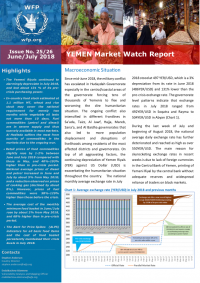Yemen Market Watch Report, Issue No. 25/26, June/July 2018
Highlights
- The Yemeni Riyals continued to alarmingly depreciate in July 2018, and lost about 131 % of its precrisis purchasing power.
- In-country food stock estimated at 1.1 million MT, wheat and rice stock may cover the national requirement for mere ly two months while vegetable oil lasts not more than 10 days. Fuel commodities (petrol and diesel) are in severe supply and thus scarcely available in most markets.
Al Hodieda suffers the most from scarcity of commodities in the markets due to the ongoing war. - Retail prices of food commodities slightly rose by 1-2% between June and July 2018 compared with those in May, and 40%-103% higher than in pre-crisis period.
National average prices of diesel and petrol increased in June and July by about 5% from May 2018; and a reduction observed on prices of cooking gas (declined by about 8%). However, prices of fuel commodities were 58%-129% higher than those before the crisis. - The average cost of the monthly minimum food basket in June/July rose by about 2% from May 2018, and 68% higher than in pre-crisis period.
- The Alert for Price Spikes (ALPS) indicators for all basic food items and the cost of food basket persistently maintained their crisis levels in July 2018.
Macroeconomic Situation
Since mid-June 2018, the military conflict has escalated in Hudaydah Governorate especially in the central/coastal areas of the governorate forcing tens of thousands of Yemenis to flee and worsening the dire humanitarian situation. The ongoing conflict also intensified in different frontlines in Sa’ada, Taizz, Al Jawf, Hajja, Mareb, Sana’a, and Al Baidha governorates that also led to more population displacement and disruptions of livelihoods among residents of the most affected districts and governorates. On top of all aggravating factors, the continuing depreciation of Yemen Riyals (YER) against US Dollar (USD) is exacerbating the humanitarian situation throughout the country. The national monthly average exchange rate in July 2018 stood at 497 YER/USD, which is a 3% depreciation from its rate in June 2018 (486YER/USD) and 131% lower than the pre-crisis exchange rate. The governorate level patterns indicate that exchange rates in July 2018 ranged from 492YER/USD in Soqatra and Rayma to 504YER/USD in Abyan (Chart 1).
During the last week of July and beginning of August 2018, the national average daily exchange rate has further deteriorated and reached as high as over 550YER/USD. The main reason for skyrocketing exchange rates in recent weeks is due to lack of foreign currencies in the Central Bank of Yemen, printing of Yemeni Riyal by the central bank without adequate reserves and widespread reliance of traders on black markets.
https://reliefweb.int/report/yemen/yemen-market-watch-report-issue-no-2526-junejuly-2018


